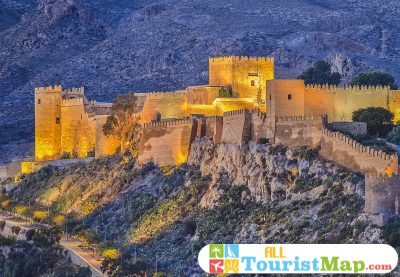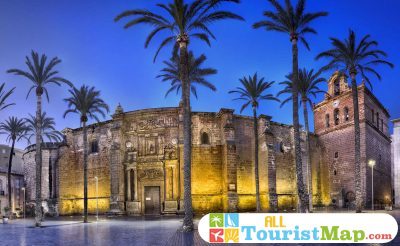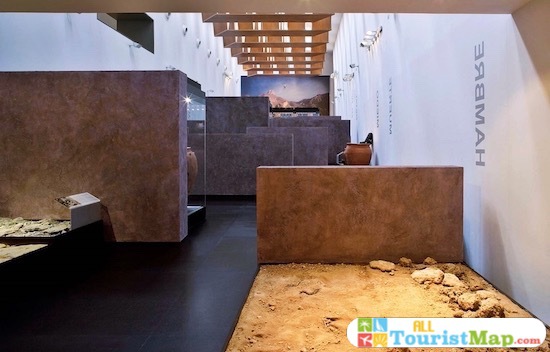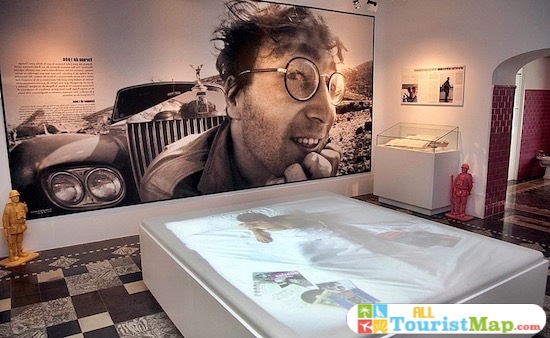We invite you to enjoy the winds and the sea of Almeria. A sea that moves under the pulse of a unique light and the warmth of the Mediterranean waters. All this explains its attraction and conditions the life of the city. A beautiful city where the airs that are gathered from the neighboring Africa are mixed with the essence of the old Europe, causing the spectacular advance that has transformed this port city in its last decades. Almeria tourist map will give you a tour of its history and tradition of the city. Almeria, where the ashes of the past still survive, a city that looks at itself in the reflection of the sea, and that easily its current presentation transports us to that past that we can still taste, feel and enjoy.
Almeria tourist map
The millenary city of Almeria, since its foundation in 955 by Abderraman III, comes to our encounter at every step in its tourist sites. It came to have the most important port of al-Andalus Umayyad, and offers the opportunity to know its history through its monuments, but also through its flavors and aromas. Our destination reserves many surprises to enjoy in its 296,200 square kilometers, under the special light of the Almeria sun. The sea is a source of life for the city, which with its 195,389 inhabitants still remembers and supports the culture of merchant shipping and fishing. Today it opens the doors to tourism to make it a driver for its future, a city that wants to move forward without neglecting its historical heritage.

The complex of walls embraced one of the most important Arab monumental sites in Spain, the Alcazaba, and still looks imposing thanks to the genius of King Hayram, whose reign achieved all the splendour of the Taifa of Almeria. Next to it is the hill of San Cristobal, where you can travel in a tourist bus, and which complements the walled complex, or what is left of it, from a higher point. From this point we can plan with a street map of the city what is presented to us. All the historical route that we have given within the city, must begin by the Cathedral of Almeria. It is convenient to go to the tourist office to define our museum and maritime route to make this experience a trip with all the details covered.
Tourist Guide Almeria
Almeria is especially an ideal city to walk around. Both the cathedral and the various buildings delimit a spacious and pleasant square where we can make a pleasant journey and take it at the pace that we want. In this tourist guide Almeria we orientate the reader about the most suitable routes to realize, and thanks to it, to do of this city a familiar section locating with facility every corner. We can learn its history and enjoy the mixture between old and new in different ways. One of them is through our palate. Here in Almeria there are many gastronomic offers and very good tapas to explore. In your places indicated in this street map you will find these points that you cannot miss.
What to see in Almeria
Alcazaba of Almeria

At the beginning of the 11th century, at the height of the splendour of the Caliphate of Cordoba, a period of disputes would take place in al-Andalus, resulting in the end of the Caliphate. After this, a multitude of independent kingdoms would emerge, called the kingdoms of Taifas. Each one of them to legitimize itself and extend its domains. In each of them, luxurious courts were created that would try to reproduce the glory of the caliphate. The seat of these was the Alcazabas, and the first king of the Taifa of Almeria was Hayran. He was responsible for the construction of numerous public works such as the walls surrounding the suburbs, including this one. It can be seen from any point in the city, and is the largest in Spain. It is a place very frequented by tourists. Here there are some impressive views of the city.
San Cristobal Hill

The city walls grew with it, passing through places like the hill of San Cristobal. It is a privileged site at a defensive level, today at a tourist level and you can get there with a guided tour. It is important to emphasize that reservations must be made because they have limited capacity, you can also include the tourist bus and the dramatized guide. A site we can visit in the San Cristóbal Hill is the city’s vantage point. For all those visitors who, once here, may have a panoramic view of the city. Especially that Muslim part of the port and be able to understand how that primitive city was from this high point. You can see what is the only remaining part of the Wall in the 12th century city. A walk through the defensive memory of Almeria, while enjoying one of the best panoramic views.
Cathedral of the Incarnation

Just 400 meters away from the old square, the Cathedral of the Incarnation stands in the very center of the city. It is a construction that incorporates a novel aspect in its design, a fortress provided with towers and battlements, and whose flat roof would serve to mount cannons. The construction is a response to the pirate attacks during the 16th century. The central courtyard of the cathedral was the space that was the old mosque. In its surroundings there are palm trees that adjoin the enclosure. This cathedral is exempted with its robust appearance, as one of the best in the genre of fortified religious buildings. Of late Gothic style, it surprises us with its Renaissance porticos, also with baroque and neoclassical notes. A visit inside the cloister and its three chapels make up a discreet and peaceful tour. If you prefer, you can include an audio guide, like any good ecclesiastical museum.
Air raid shelter

An obligatory stop in Almeria is the impressive visit to the concrete air-raid shelters that were built during the Civil War. Only nine meters deep between the protection and the hell of explosions, this complex of bunkers and underground corridors housed three quarters of the population of Almeria. It was designed by architect Guillermo Langle. The visits are guided by a group, and it is necessary to make an appointment in advance. Of the four and a half kilometers long can be visited almost a kilometer. It is considered among the largest air raid shelters in Europe open to the public. You can access areas such as a pantry store, or an operating room with all the instrumental equipment of the time, where operations, deliveries and amputations were performed. At present, efforts are being made to rehabilitate and incorporate more original spaces into the route.
Museum of Almeria

In Almería, to enjoy a good particular museum offer, you only have to visit its archaeology museum. This modern work was made possible by the architects Ángela Paredes and Ignacio García. This building was awarded for its avant-garde design, with the Academic Awards of Design and Contemporary Art 2004, and European Museum of the year 2008. In the interior the spaces are harmoniously distributed combining light, and the contours in a coffered ceiling made of wood. The Almeida Museum is designed with the 21st Century in mind. Conceptually, its museography is daring and different from the typology of provincial museums, or traditional archaeological ones. It incorporates audiovisual technologies where numerous archaeological pieces taken from the area and its surroundings can be interpreted. The museum was inaugurated by the Prince and Princess of Asturias in 2006.
House of Cinema

We couldn’t be in Almeria without going to the movie house. Located on the outskirts of the city, this farmhouse is the binding reflection between the city and the world of cinema. Here John Lennon composed the famous song StrawBerry Fields Forever. It was the place where he inspired John Lennon to compose during the months. As you can see, this place was used as an accommodation for artists. Numerous film stars besides Lennon stayed here, including Clint Eastwood and Brigitte Bardot. This hostel of film personalities had its incubation to fame in the 60s and 70s. Later, the city council acquired it to turn it into the House of Cinema. So these walls hold stories and inspirations from great artists. Today you can enter and see the importance that Almeria had in relation to the world of the seventh art.
Marina

For those who arrive by boat in the city, they will enjoy a real luxury for the view, its bay. The point of arrival is the marina. This place has several services incorporating the requirements of a modern port. In its wharf is the nautical sports club of trajectory in Almeria. There are also a number of bars, and the promenade, completed in 1986, which has become a favourite place for recreation and leisure for people of all ages. The sea, the light and the Mediterranean climate invite you to stroll and practice sport. It would be nice to have a look at one of its many terraces to simply let yourself be caught by one of the most beautiful sunsets you can find.
Heritage Interpretation Centre

When visiting Almeria it is advisable to have a base of their background. It would be a sin to pass by this city and ignore the diverse cultures that had influence here. To better understand its mixed art, perhaps a little confusing for the newcomer, it is not enough to rely on the architecture, you have to know how to interpret it. In the middle of the central part of the city is located the center of patrimonial interpretation of Almeria, created with the purpose of stimulating the cultural tourism. This interpretation centre is divided into stages of local history, the Muslim stage, the Christian stage, the contemporary and current stage. The route is well structured and covers the aspects, monuments, protagonists and events that defined the history of this city.
Almeria Walkway

The Paseo de Almería connects with the Rambla de Federico García Lorca, and is the real backbone of the city. On this road you can find a wide range of restaurants, as well as shops, clothing stores and cafes, both traditional and modern. This offer even extends to the streets that connect with this main artery. The arrangement of this central space was the greatest urban transformation in Almeria during the last century. What was a dry riverbed that divided the city became an integration promenade, and therefore, a meeting place for the people of Almeria recovering the presence and sense of the sea. This point is projected as a reference of pedestrian corridor. It is increasingly common to hear of this walk more often, in which Almerians and foreigners converge in this dance of leisure and recreation.
Almeria Seafront Promenade

This walk is 7 kilometres long. Here is the beach el Zapillo, is the reference beach of Almeria. Here the sand is dark and is very popular in the summer. It starts at the Puerta de Purcherna and ends at the marina, i.e. between the historical centre and the marina. Ideal for jogging, cycling or rollerblading, and of course a walk. Around it there are a lot of shops, hotels and restaurants. Nothing better to compensate for the sunny climate of the area, than an excellent shopping area where bars and tapas are the center of attraction. Together with the Paseo de Almería they constitute the main tourist arteries of the city.
Almeria Hotel Map
This city, always linked to the sea and to history, deserves to be visited without interruptions. The invitation is to stay a few days and enjoy all the options that this varied and innovative city has to offer. Above all, because of the cultural and nightlife offerings it has been developing. In Almeria map of hotels we indicate the most central hotels, and our recommendation is Hotel Catedral. It has an impeccable attention and elegant rooms. This was a 1,850 year old building, an old bourgeoisie house, and inside the building there is a 1,000 year old Arab cistern. They have also managed to respect the configuration of the original corridors and the dimensions of the ceiling, combined with contemporary minimalism. It finishes with a good view of the cathedral. A privileged point in the city.
